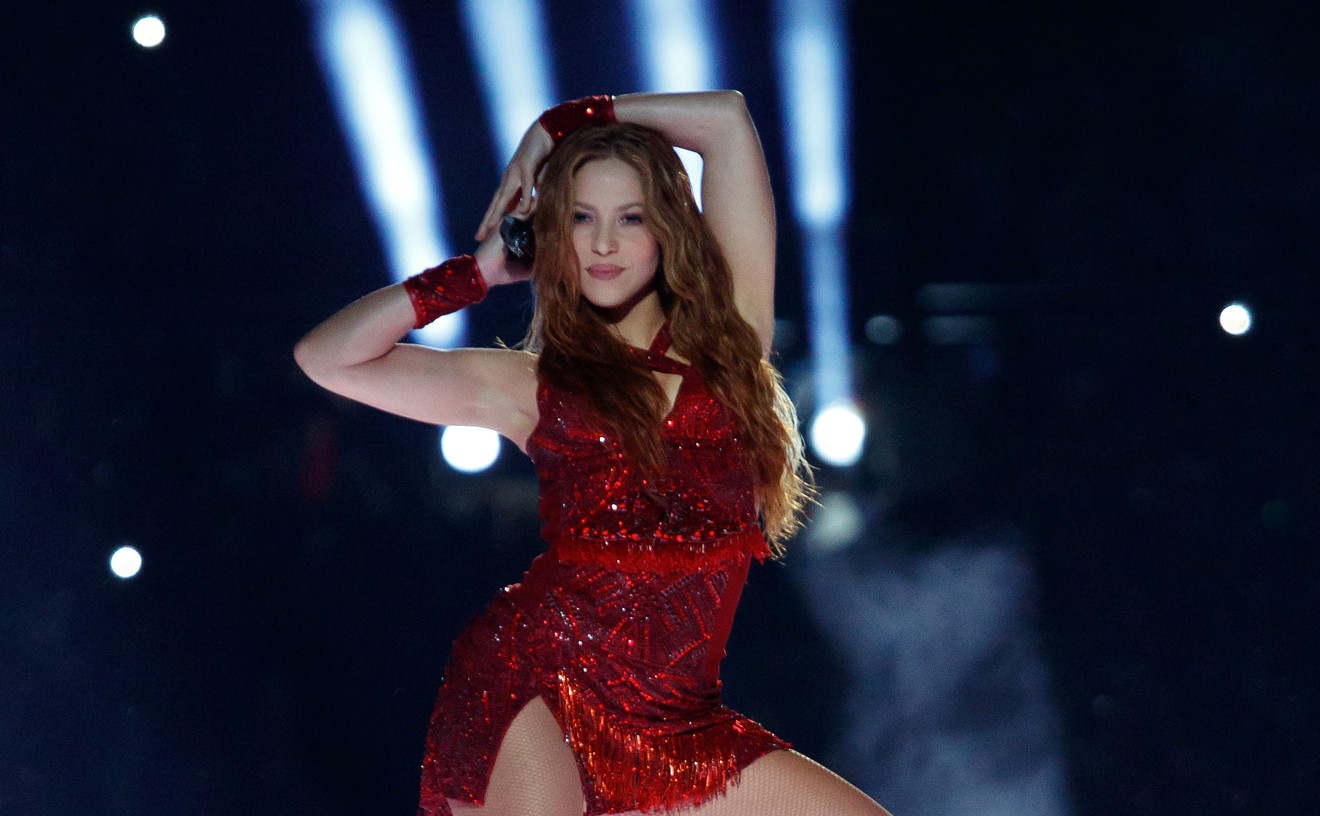Actually, there were two lines outside. The shorter one on the left was for South by Southwest badge holders, the privileged many, who nervously wondered whether they would make it inside. On the right were wristband wearers, the much-abused Cinderellas at every SXSW ball. Most of these people weren't so nervous, 'cause they knew they weren't getting in.
In a way, the Sonic Youth gig had little to do with SXSW. It was essentially a show booked for a private party, until SXSW stepped in and made it a conference-sanctioned event. But in a deeper sense, the Sonic Youth mayhem defined what SXSW is all about.
The ostensible point of this 12-year-old music confab is to showcase promising, obscure bands. When the Austin, Texas, organizers of the convention put this idea together in 1986, they were fueled by a zealous belief in the music of their region and a desire to make the rest of the music industry take notice. How did that beautiful concept devolve into hordes of jaded music bizzers tussling for a chance to see a 17-year-old band that practically everyone had already seen a million times? We could go to Mason Jar for that.
The problem isn't with Sonic Youth, per se. In spite of its eventual major-label capitulation and brief flirtation with rock stardom, the band has generally been an uncompromising model of integrity and fearlessness in a cowardly industry.
At La Zona Rosa, the band's show leaned heavily on noisy guitar interplay and shunned traditional song concepts, to the point where not a vocal was heard until 10 minutes into the set. It was an admirable return to the band's roots, but all the same, anytime you return to your roots, you're treading on soil that's no longer fresh. In a way, seeing Sonic Youth revisit its original direction was about as predictable as watching Duran Duran kick into "The Reflex" for the umpteenth time.
A bigger concern is that SXSW attendees similarly get sidetracked into revisiting past glories. No matter what you think of Soul Asylum, Robyn Hitchcock, Buddy Guy or Nick Lowe, you have to agree that all these artists made their marks long ago. Everyone who's interested in them has had multiple chances to catch them in the act.
These artists don't need SXSW to build their careers, and SXSW attendees don't need these acts getting in the way of undiscovered bands. For some reason, SXSW blithely pretends it's a showcase for new talent, when it's really a chance for music bizzers to cling to what they know. Personally, I knew that the bloom was off the rose when I heard people on my flight to Austin talking excitedly about wanting to catch Tommy Tutone at SXSW.
But in actual fact, there is no single event that we can call SXSW. There are many SXSWs going on at the same time in separate galaxies that share the same zip code and the same cover charge. Even if you race from club to club, you're unlikely to catch more than 5 percent of the 800 bands on display. Inevitably, your SXSW experience will be different from everyone else's. So, once you resign yourself to the fact that it's impossible to have a definitive SXSW experience, you just try to catch as many good bands as you can and limit yourself to 12 Raspberry Ales per night. So what follows is one person's subjective--and somewhat booze-addled--version of the highlights and lowlights from SXSW, Volume 12.
Panels and Workshops: Panel discussions at SXSW tend to be divided into two categories. You have the nuts-and-bolts practical-advice sessions, which pretend to offer pointers for aspiring bands (Pop a tape in someone's hand, are you taking notes?) but tend to be as dry as a Baptist county in June. The other type consists of the sort of wacked-out esoterica that serves no practical function ("Who Killed Bobby Fuller?") but is considerably more fun. At least this year, all the topics were connected to music, as opposed to past conventions when critics actually attempted to analyze what makes Texas barbecue so distinctive.
Keynote speaker Nick Lowe kicked things off with a welcome dose of sanity, saying that he can't be bothered to complain about the music industry. "That's a place I grew out of years ago," Lowe said. "You reach a point where you just don't care." After about 10 minutes, Lowe slipped into SXSW mode by shamelessly promoting his new CD, with a solid acoustic performance of four tunes, capped off by the obligatory "(What's So Funny About) Peace, Love and Understanding."
The A&R panel would have been a useless bore, if not for the friendly jibes from HITS editor Joe Fleischer at Steve Greenberg, Mercury vice president of A&R, who refused to let the audience forget that he was the man who signed Hanson. When someone asked what the Hanson brothers will do when their voices change, Greenberg said their voices have already changed and made the ludicrous claim that the eldest Hanson "sounds like a young Otis Redding." Fleischer immediately chimed in: "Sings like Otis Redding, looks like Cindy Brady."
Kate Hyman of V2 Records thankfully burst this panel's bubble of industry-speak when a questioner asked what record labels need now. Her response: "More people who love music."
Most of the other nuts-and-bolts panels failed to generate anything but drowsiness. One exception was the songwriters panel, which turned into a peek inside the often-complicated creative process. Seated on the left were highly successful Nashville pros Tia Sillers and Willie Nelson look-alike Aaron Barker, while on the right sat underappreciated mavericks Peter Holsapple and Alejandro Escovedo. Sillers talked about big hits she's written for people like Kenny Wayne Shepherd and somewhat abashedly confessed that she works to meet a quota of 12 songs a year. Escovedo, looking like someone's grizzled uncle in an ill-fitting hat, introduced himself by saying, "I've written a bunch of songs. I've never had a cover or anything and I guess this song will show you why." Before the laughs had subsided, he proved his point by singing a mournful verse that began: "I was drunk, I was down." Not exactly LeAnn Rimes fare.
By far the most interesting panel I attended, however, was a discussion on Paul McCartney called "So Is Paul Dead?". At first glance, it looked like one of those esoteric wank fests that serves no purpose but to let critics hear the sound of their own voices. But this surprisingly heated debate actually touched on a variety of themes that bubble under the surface at SXSW: What does rock 'n' roll mean in this day and age? Is music the province of youth? What should you do when your creativity starts slipping? Do you need to suffer for your art?
Predictably, the critics on the panel--Jim DeRogatis and Nirvana biographer Michael Azerrad--bashed Paulie for "phoning it in" and living off his Beatles reputation for the bulk of his solo career. The artists and record-label people on the panel rushed to McCartney's defense. Singer-songwriter Vic Chesnutt introduced himself by saying, "Yoko is my favorite Beatle, but I also love Paul." Both Chesnutt and power-pop hero Tommy Keene said that they were moved by several songs on McCartney's recent Flaming Pie album, and refuted Azerrad's contention that McCartney's work is "emotionally barren" craftsmanship. When Azerrad suggested that McCartney was too rich to have "grist for his mill," and needed to give up his money and go live among starving artists in New York, Chesnutt ridiculed him by saying, "Michelangelo was living in total opulence when he made the Sistine Chapel."
The most apt question came from an attendee who wondered if Azerrad would know when to hang it up if he felt his own work was starting to slip. The 37-year-old Azerrad said burnout is an issue that he grapples with every day, but clearly he didn't relish having the tables turned on him.
A burly radio program director from Columbus, Ohio, brought the proceedings to a close by saying, "Paul can do whatever he wants, 'cause he made my life better. If he wants to do a spoken-word album, woo-hoo, have at it." Even the critics laughed.
Showcases: The big moments at SXSW come when you take a chance on someone you've never heard before and experience something memorable. For me, that came with a Thursday-night showcase by Eszter Balint, best known for playing John Lurie's Hungarian cousin in Stranger Than Paradise. Thirteen years after that film, Balint is not only sleek and gorgeous, but she fronts a talented, quirky band that incorporates accordion, banjo and her own violin breaks. Balint's smoky vocals perfectly suited the moody ambiance of this postmodern lounge music.
On Friday, the Matador showcase at an overcrowded Electric Lounge qualified as must-see rock. Sean Lennon jostled among the throng, while Janeane Garofalo was seemingly spotted by everyone but me. Arab Strap delivered some fine, grindingly slow rock, while Japan's Cornelius offered a wild, campy synth-ride, heavy on strobe lighting and non sequitur video footage of boxing. By midnight, the club was so packed that it looked like Come would have to be airlifted to the stage. The Boston quartet proceeded to lift the hinges off the doors with a slamming set of mighty guitar madness. Thalia Zedek's howl-at-the-moon vocals again proved that she's one of those rare singers for whom words are unnecessary. The mere sound of her voice conveys everything.
After that, the languid Bardot Pond could not hope to compete although its lead singer was a beautiful wreck, in a leopard-skin outfit and positively oozing heroin-chic poutiness. Outside, under the pavilion tent, The Promise Ring was a much more life-affirming alternative experience, poppy and punky, without demeaning either concept.
On Saturday, The High Llamas kept a packed crowd waiting for almost half an hour while they prepared their intricate stage setup, but their sonorous set--heavy on vibes and tape loops--made up for any tardiness. At Copper Tank, The Waco Brothers brought down the roof on Bloodshot Records' showcase with a typically drunken set of country rowdiness. Jon Langford and his mates proved that three hoarse shouters singing in unison can actually be more effective than one honey-voiced country crooner. They were so loose that Langford actually stopped the band in midsong to ask if anyone could provide him with the lyrics to Neil Young's "Revolution Blues."
The two bands whose names earned the most buzz at SXSW were Olivia Tremor Control (whose experimental pop turned heads at Electric Lounge) and Propellerheads, a British techno act whose new album is snagging much attention stateside. Propellerheads were a high point of La Zona Rosa's Friday electronica night, and their mix of live instrumentation, sampling and turntable scratches seemed to hit the spot for even the most techno-resistant ears.
Though I couldn't catch every local band at SXSW, the ones I did see acquitted themselves nicely. Beat Angels had the difficult task of following a rustic Texas bluegrass band called The Fencesitters, but they kicked out the jams with aplomb. Phunk Junkeez generated a near mosh frenzy at Atomic Cafe the next night. Grievous Angels snugly fit in with the country-friendly environs of Austin and made honky-tonk magic with their gender switch on Patsy Cline's "She's Got You."
But the most impressive Arizona band at SXSW for me was Jimmy Eat World. Though lead singer Jim Adkins suffered from a sore throat, he and the band threw down with such nuanced fury and rhythmic cohesion that they made it hard for any band to follow them. Seeing this group of local heroes deliver the goods on foreign turf made all the little annoyances of SXSW much easier to endure.









